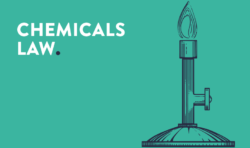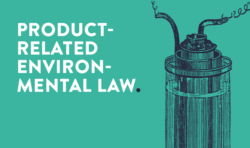This article is the first in a series of blog posts with the joint title “What’s changing in 2024“, in which the experts from Produktkanzlei team summarise the relevant topics from their respective areas of expertise.
In this article the changes in product-related environmental law that have already been adopted and are still in the legislative process are presented in a first part (see A.). In a second part, the numerous provisions on due diligence obligations in the supply chain are placed in their temporal context (see B.).
A. Product-related environmental law
In the broad, increasingly complex and closely interwoven network of sustainability-related requirements for products, the EU Battery Regulation (see I.) and the legislative process for an EU Packaging Regulation (see II.) are likely to be the focus of interest in 2024. However, 2024 will also see far-reaching developments in numerous other areas, such as the entry into force of the Single-Use Plastics Funds Act and various sector-specific initiatives, for example in the automotive and textile sectors (see III. for an overview).
I. EU Battery Regulation
Although Regulation (EU) 2023/1542 (EU Battery Regulation) came into force on 17.08.2023, it will only apply from 18.02.2024 in accordance with Art. 96 para. 2 sentence 1. However, due to further transitional provisions specific to obligations and roles, which are anchored in various parts of the Regulation, the vast majority of obligations will only apply from 18.08.2024 at the earliest.
This applies in particular to the obligations of economic operators under Chapter VI (Art. 38 ff. BattVO; cf. Art. 96 para. 2 sentence 2 letter b) BattVO). While many of the sustainability-related manufacturer obligations from Art. 6 ff. BattVO, apart from Art. 6, 12 and 14 BattVO, will only have to be complied with at a later date, Art. 38 BattVO nevertheless provides for some requirements that must already be implemented from 18.08.2024:
- Each battery must be accompanied by clear and comprehensible instructions and safety information in writing in the respective languages of the Member States in which the battery is placed on the market.
- Technical documentation must be prepared for each battery model in accordance with Annex VIII BattVO and a conformity assessment procedure must be carried out in accordance with Art. 17 BattVO. After successful completion, an EU Declaration of Conformity (Art. 18 BattVO) must be issued and CE labelling (Art. 19 and 20 BattVO) affixed. In connection with the CE marking, it should be noted that batteries with a CE marking may not be placed on the market before 18.08.2024, which must be urgently taken into account when planning the timing of production, delivery and customs clearance.
- In addition, from 18.08.2024, batteries must be labelled with a model identifier and a batch or serial number or a product number or other means of identification (Art. 38 para. 6 BattVO). In addition, from this date, manufacturers must also indicate their name, registered trade name or registered trade mark, postal address and, if available, the internet address and e-mail address (Art. 38 para. 7 BattVO).
Importers are also subject to certain testing and labelling obligations from 18.08.2024:
- They must ensure that the necessary technical documentation has been drawn up, the conformity assessment procedure has been carried out, an EU declaration of conformity has been issued and CE labelling has been affixed.
- They must also ensure that the operating instructions and safety information are provided in the required languages.
- Furthermore, they must check whether the markings in accordance with Art. 38 para. 6 and 7 BattVO have been affixed by the manufacturer.
- Finally, the importer himself must also indicate his name, registered trade name or registered trade mark, postal address and, if available, the internet address and e-mail address directly on the battery (Art. 41 para. 3 BattVO). If this is not possible, labelling on the packaging or in an accompanying document may be considered.
From 18.08.2024, distributors will also be subject to inspection obligations comparable to those of the importer in accordance with Art. 42 para. 1 and 2 BattVO.
Finally, it should be noted that, despite the imminent date of application, numerous issues remain unresolved and are causing a great deal of concern among the economic operators involved. This concerns the following aspects, among others:
- Differentiation between portable and industrial batteries with decisive effects on the applicability of the substance restrictions for lead according to Art. 6 in conjunction with Annex I No. 3 BattVO. This particularly affects numerous applications in the area of emergency power supplies for products, which are currently often based on lead-containing accumulators and for which a changeover within a few months may not be possible or reasonable.
- Relationship between the labelling requirements of Art. 13 para. 1 in conjunction with Annex VI Part A (1) and (2) BattVO and Art. 38 para. 6 and 7 BattVO. This is because the aforementioned chain of references from Art. 13 BattVO refers directly to the labelling according to Art. 38 para. 6 and 7 BattVO, but the two provisions result in different dates of application (18.08.2024. or 18.08.2026) and different alternative options if labelling directly on the battery is not possible.
- Definition of a distributor according to Art. 3 para. 1 No. 65 BattVO in the conflict between sustainability-related requirements (Art. 42 BattVO) and take-back obligations (Art. 62 BattVO). The current definition explicitly excludes manufacturers and importers from the definition of distributors, which is understandable and correct for the purposes of Art. 42 BattVO but can lead to considerable regulatory gaps in the take-back obligations under Art. 62 BattVO.
In light of the complex structure of obligations, the need for the EU Commission to fill in numerous details by means of tertiary legislation and the existing uncertainties, the economic actors concerned should draw up a practicable implementation plan as quickly as possible and authorities should be open to the concerns of economic actors in order to prevent the life cycle-oriented revolution intended by the regulation from failing. A moderate reorganisation of the German Battery Act, which is expected in 2024, will also be able to make an important contribution to this.
II. Proposal for an EU Packaging Regulation
After the EU Battery Regulation, packaging law is to be the second area of law to be reorganised from a waste approach to a life cycle regulation. After almost exactly one year of debates, the EU Parliament and the Council adopted their respective negotiating positions in November and December 2023 for the upcoming trilogue negotiations. These will now begin in the near future and should be driven forward with vigour. It is uncertain whether the trialogue can be concluded before the EU elections in mid-2024, in particular due to the sometimes widely divergent negotiating positions. In light of the transition period of at least twelve or even 18 months from the entry into force of the regulation provided for in the current drafts, there will in any case be no implementation obligations in 2024.
Some of the controversial topics for the trilogue negotiations can be summarised as follows:
- Harmonisation, in particular with regard to labelling requirements – while the Parliament is more in favour of full harmonisation, the Council is in favour of retaining opening clauses in favour of Member State supplements
- Definition and scope of recyclability requirements (“design for recycling“)
- Definition and scope of reuse solutions
It should only be mentioned here as a side note that the “Act for Less Packaging Waste” announced by the BMUV in mid-2023 to amend the German Packaging Act has probably been lost in the departmental coordination process. At the very least, apart from a key issues paper, there is no published draft to date. In view of the progress of the legislative process for an EU Packaging Regulation, it is doubtful, at least in terms of timing, whether this legislative plan will or should be pursued any further.
III. Further developments at a glance
Despite these two flagship projects, we should not lose sight of the fact that numerous other requirements in the area of product-related environmental law are being developed or will come into force in parallel.
1. Proposal for a regulation on the circular design of vehicles and the disposal of end-of-life vehicles
With this proposal, the EU Commission wants to harmonise the legal framework for the construction, repair, disposal and export of vehicles and develop it further in line with a life cycle-oriented regulatory concept. To this end, the End-of-Life Vehicles Directive 2000/53/EC and the 3R Type Approval Directive 2005/64/EC are to be repealed and merged in terms of content. Although the legislative process is still in its infancy, it is expected to make significant progress in 2024. Despite the envisaged transitional provisions of three to six years, all affected economic operators should formulate their concerns clearly, as the proposal in its current version still suffers from significant shortcomings that would often have the exact opposite effect to that intended by the legislator.
We will report on this in detail in a separate blog post at the end of January.
2. Proposal to revise the EU Waste Framework Directive – extended producer responsibility for textiles and footwear
Contrary to the regulatory system of life-cycle-spanning regulation described with regard to the three legal areas above, this proposal is “only” intended to introduce a regime of extended producer responsibility for textiles and footwear. The requirements for the labelling of textiles, in particular the fibre composition, are expected to be tightened by an announced amendment to the EU Textile Labelling Regulation (EU) No. 1007/2011. The Ecodesign Regulation is also likely to include requirements for the sustainable design and manufacture of textiles and shoes, although no specific initiative has yet been launched. In terms of timing, there will in any case be relevant developments in 2024 with regard to extended producer responsibility and textile labelling, although it is not expected that implementation obligations in this regard will take effect this year.
Further details are available in our blog post “Extended producer responsibility for textiles and shoes”.
3. Amendment of the EU Cosmetics Regulation
While a comprehensive amendment to the EU Cosmetics Regulation (EC) No. 1223/2009 is still not foreseeable, two regulations have recently introduced new substance-related requirements into the EU Cosmetics Regulation.
On the one hand, this concerns the inclusion of new CMR substances in Annex II of the EU Cosmetics Regulation by Regulation (EU) 2023/1490, which has been in force since 01.12.2023. On the other hand, Regulation (EU) 2023/1545 included 56 new allergenic fragrances in Annex III of the EU Cosmetics Regulation, for which the relevant labelling requirements will have to be complied with from 31.07.2026.
Further details are available in our blog post “New prohibited and restricted substances in cosmetic law”.
4. Electrical and electronic equipment legislation
Despite several announcements regarding the revision of both the legal framework for the collection, return and treatment of waste equipment in accordance with Directive 2012/19/EU (WEEE) and the requirements for substance restrictions in electrical and electronic equipment in accordance with Directive 2011/65/EU (RoHS), no concrete developments are currently foreseeable in this regard. Unfortunately, this also continues to apply to the decisions on extension applications that have been pending for years, in particular for the lead exemptions under points 6 and 7 of Annex III RoHS.
At national level, too, the revision of the ElektroG announced for autumn 2023 has so far come to nothing, so it remains to be seen whether a corresponding legislative procedure will be initiated in 2024. Only the ElektroGBattGGebV was amended on an annual basis with effect from 01.01.2024. While the majority of fees for ElektroG registration have been reduced, the quarterly fee for registered ElektroG manufacturers has almost doubled and other fees in connection with the ElektroG and BattG are also tending to increase.
5. Single-use plastic fund
Some relevant parts of the EWKFondsG came into force on 1 January 2024. Accordingly, new market players who place single-use plastic products on the market must register with the UBA from 1 January 2024; for manufacturers already active on the market before 1 January 2024, a transitional period until 31 December 2024 applies. However, it should be noted that the required registration platform “DIVID” is not yet provided by the UBA and therefore registration is currently not yet possible. According to the UBA, the platform should be available by 1 April 2024. Until then, new market players will of course also be able to place products on the market without registration, and even after the platform goes live, enforcement will initially be based on a sense of proportion, at least according to the UBA’s current statement.
However, a levy of the EU plastic tax for plastic packaging appears to be off the table again, at least for 2024, despite a corresponding decision by the German government.
B. Due diligence obligations in the supply chain
Like the requirements for the products themselves, the requirements for due diligence obligations in the supply chain are becoming increasingly important in sustainability legislation and business practice. It is therefore not surprising that there will also be relevant developments in 2024.
I. Supply Chain Due Diligence Act (LkSG)
Since 01.01.2024, the LkSG is no longer only applicable to companies with 3,000 or more employees, but now has a threshold of 1,000. This means that more than twice as many companies now fall directly within the scope of application, which will once again noticeably increase the pressure on small and medium-sized suppliers in particular.
In addition, the inspection activities of the responsible BAFA will probably also increase. While in 2023 it only focused on the designation of responsibilities and the establishment of complaints mechanisms, this year it will, according to its own announcements, put the implementation of company-specific risk analyses under the microscope. Since the risk analysis can be described as the centrepiece of the due diligence obligations, because all preventive and remedial measures are based on it, and the BAFA’s requirements in this regard in the handouts published to date go well beyond the wording of the LkSG in some cases, the first (legal) disputes are likely to be expected.
Finally, the BAFA has announced that it will review the reports required under Sec. 10, 12 and 13 LkSG on the implementation of due diligence obligations for the first time from 01.06.2024. In addition, the newly introduced sustainability reporting obligation under the Corporate Sustainability Reporting Directive (“CSRD”) will also apply to certain companies from 2024.
II. EU directive on due diligence obligations of companies with regard to sustainability (CSDDD)
On 14.12.2023, the institutions involved in the legislative process announced a provisional agreement on the CSDDD, although the consolidated text of the agreement is not yet publicly available. This means that nothing should stand in the way of its adoption in the coming months. However, due to its legal form as a Directive, the requirements of the CSDDD will not apply directly, but must first be implemented by the Member States (in Germany in the LkSG), for which a deadline of 2026 is likely to be set.
Compared to the current status of the LkSG, there will be an expansion of the scope of application, additional protected legal positions and environmental concerns and civil liability.
III. Regulation on deforestation-free supply chains
The due diligence obligations introduced by Regulation (EU) 2023/1115 in connection with the relevant raw materials cattle, cocoa, coffee, oil palm, rubber, soya and wood must be complied with from 30.12.2024. However, compliance with the stipulated due diligence obligations requires extensive preparatory measures in cooperation with global suppliers, so that 2024 should be used for this purpose in order to avoid marketability obstacles at the end of the year.
Further details are available in our blog posts “Regulation on deforestation-free supply chains” and “Regulation on deforestation-free supply chains published in the EU Official Journal”.
IV. Proposal for a Regulation banning products made with forced labour on the Union market
While the EU Parliament has now cleared the way for trilogue negotiations on this proposal, an initial decision in the Council is still pending. However, the Council is expected to adopt a position in the first half of 2024, meaning that the trialogue negotiations on this proposal are also likely to begin in 2024. In any case, it is unlikely to be finalised before the end of the year.
Conclusion and outlook
In summary, it can be said that product-related sustainability legislation is currently characterised by an unprecedented dynamic. While the fundamental goals of promoting ecological and social sustainability and environmental protection cannot be seriously questioned, an increasing number of question marks remain when reading adopted and proposed laws. However, as legal structures become increasingly impenetrable and detach themselves from practical realities or feasibility in favour of theoretical ideals, the positive objectives often fade into the background of detailed interpretative debates. In future, legislators should therefore once again endeavour to formulate coherent, solution-oriented, comprehensible and implementable requirements in order to redirect the focus of all those involved back to the actual objectives.
Do you have any questions about this news, or would you like to discuss it with the author? Please contact: Michael Öttinger





